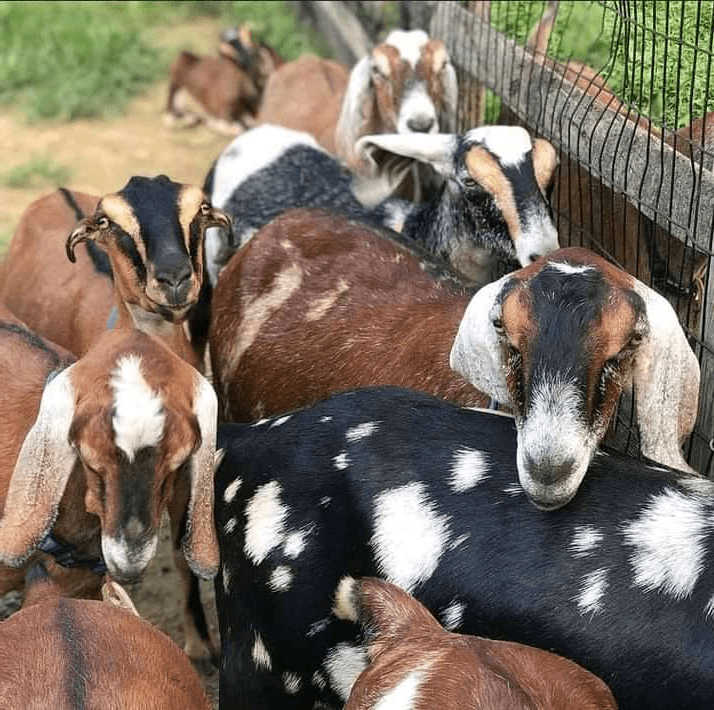With long, floppy ears, a noble bearing, and inquisitive eyes, the Nubian goat is an adorable mammal. However, this animal has more to offer your homestead than just its cuteness. Nubians are raised for their milk as well as their meat, giving you and your family a food source and several revenue possibilities for the homestead when you raise them.
There are many reasons that the Nubian goat is the most popular breed of goat in the United States.
Nubian Goat History
The Nubian goat is named for its place of origin. The Upper Nile Valley is sometimes called Nubia, and that is where this lovely goat breed began. In the mid to late 1800s, goat breeders from the United Kingdom imported a handful of goats from the Middle East, Africa, and India. These goats had some characteristics that the British breeders desired to incorporate into their herds.
The Middle Eastern goats were then bred with existing British milk goats. The British goats had some Swiss dairy influence. The resulting offspring became what is now considered the Nubian goat. Sometimes, these goats are called the Anglo Nubian goat in Great Britain. It is simply called the Nubian in the United States. Anglo Nubian goats were imported to the United States in the early decades of the 1900s.
Breed Characteristics and Appearance
The most notable characteristic of Nubian goats is their long, pendulous ears. Their ears are bell-shaped and dangle at least an inch below the goat’s head. Nubian goats’ long ears help cool them in warm climates. However, they can be prone to frostbite.
Their nose is also rather distinctive, being rather convex or “Roman” in shape. This gives the Nubian goat a very exotic and aristocratic bearing. Nubians have large almond-shaped eyes and wide foreheads.
Nubians have black or brown horns that may begin growing as early as three weeks of age. Male Nubian goats may experience 8 to 12 inches of horn growth in their first year. Eventually, the Nubian bucks will have horns up to 2 feet in length. If you do not want goats with horns, you can choose to dehorn them when they are young, around 14 days old. This is called debudding. Learn more about goat horns.
Nubians are generally considered to be a larger breed of goat. Full-grown Nubian goat bucks stand about 36 inches tall, while the does are about 32 inches tall at the shoulders. Buck Nubian goats weigh in around 175 to 200 pounds, and the does weigh about 140 to 150 pounds.
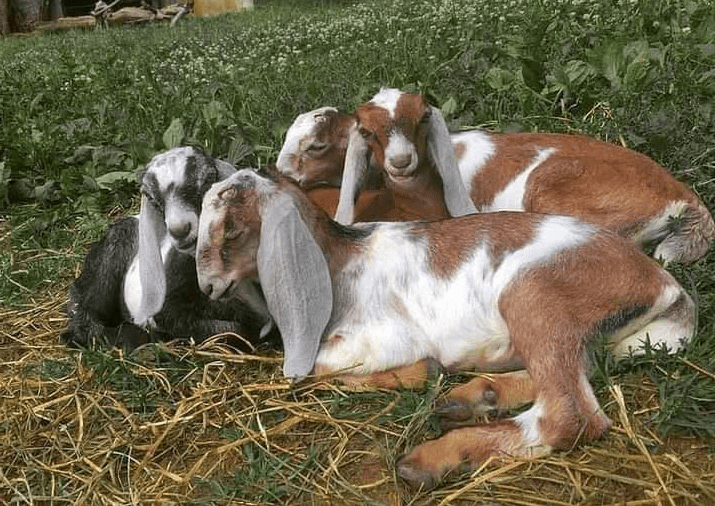
Nubian goats have short, sleek coats. The fur on their ears is unusually silky and begs to be stroked. They also come in a wide variety of colors. You may find a Nubian goat in red, brown, gray, and white as well as all sorts of stripes and speckles. Usually, Nubian goats have black or white facial markings.
Mini Nubian Goats
There are also Mini Nubian goats. These goats are a mix of a standard-sized Nubian goat bred with a Nigerian Dwarf goat. They are considered to be good milk producers but produce less than traditional Nubian does. This may make them more manageable for smaller farms or for people getting started in dairy goat farming. Nubians are great goats for those who want to make cheese.
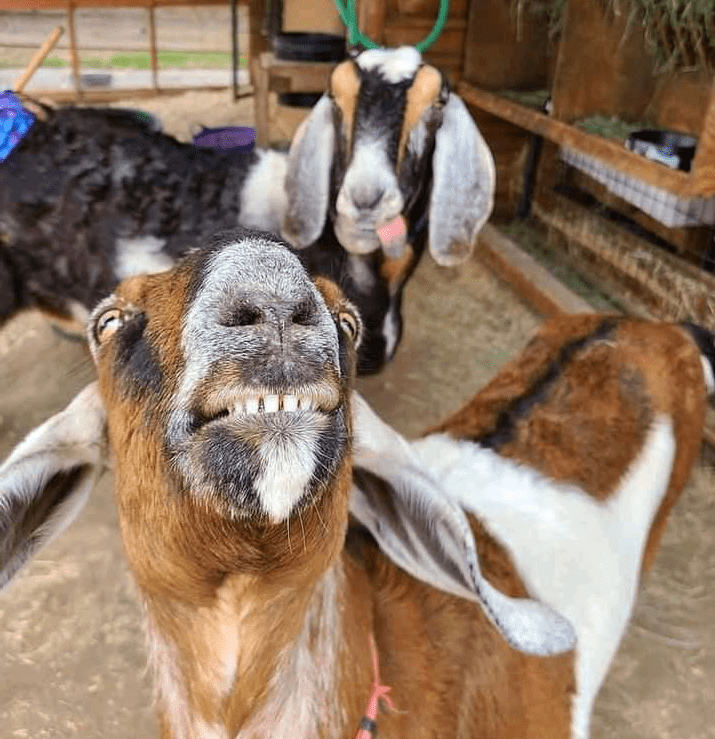
Uses for Nubian Goats
For milk
One of the reasons people raise them is for their milk. Nubian goats may produce a bit less milk than other breeds of dairy goats. However, they have milk that is of excellent quality and flavor. The milk of a Nubian is higher in butterfat, around 5%, making it higher than milk from many other goat breeds. Nubian milk has a complex, rich flavor and butterfat, making it excellent for making dairy products such as cheese, butter, etc.
Additionally, the fact that these goats can produce milk all year round makes them a great choice for those who want to sell milk from their farm. You will not have a time when all your goats are dry if you raise Nubian goats. Of course, selling unpasteurized milk may not be legal in all areas, so you should check your local regulations before you begin this kind of business. There are many safety precautions you will need to learn.
As pack animals
The Nubian is not only used for dairying. Some people use their Nubians, particularly their wethers (castrated males) as pack animals. These animals are smart and strong. Therefore, they can be easily trained to pull a cart or carry heavy packs in remote settings. If you like to hike or live in a remote place, a few Nubian goats might make sense as pack animals.
For meat
Nubian goats also make good meat goats as well. They provide more meat than most dairy breeds. In your herd, you can castrate the male animals and raise them for meat. You can allow the females to grow up and use them to milk, to raise babies for sale, or you can sell them to other farmers as home dairy animals.
As pets and companions
Some people raise Nubians as pets. These goats are gentle, curious, and friendly. Therefore, they do make good pets. However, an intact male goat, a billy goat, should never be used as a pet. As intact males grow up, they can suddenly turn aggressive. These animals could be dangerous if someone is not watching out for typical billy goat behavior.
Feeding Nubian Goats
The Nubian goat breed is highly adaptable to its environment. They graze on a wide variety of plants. In fact, they prefer mixed pastures that have brush and are partially wooded over pastures that are solely grasses. These goats like to eat brush, shrubs, the tips of tree branches, poison ivy, and even briers. You should provide at least half an acre of pasture for each goat in summer.
If you are milking your Nubian does, it is crucial that you feed them correctly. Each goat will need 3% to 4% percent of their body weight in hay per day in winter. This means that a 150 pound goat will need about 6 pounds of hay each day. This will increase if the weather is very cold. Alfalfa hay will provide additional protein to keep your does in good shape over the winter while in milk.
When milking, the does will require a high protein grain supplement. These does will need about a pound of 14% to 16% percent protein grain per gallon of milk that is produced. Do not suddenly increase her grain ration to this amount. You should slowly work up to this amount in the last 4 to 6 weeks of her pregnancy.
Along with their food, Nubian goats need a mineral supplement. This should include copper since that is a mineral that is essential for goats.
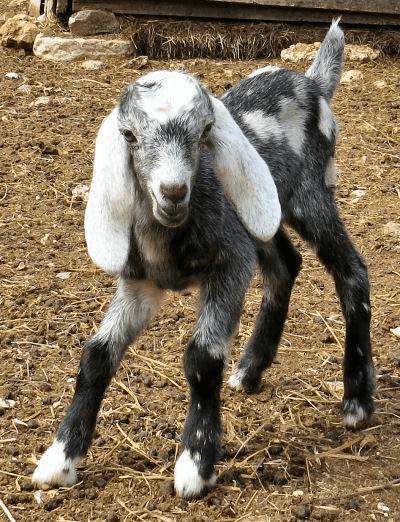
Breeding Nubian Goats
Nubian dairy goats have an advantage over many other dairy breeds in that they will breed all year long. This means that you can have fresh milk at any time of the year. These are very fertile goats, and they will continue breeding long after other goat breeds are too old to be fertile. Some Nubian nanny goats have been known to breed and give birth well after their twelfth year.
Nubian goats become sexually mature at extremely early ages. Therefore, you should keep intact males away from the females as early as 8 weeks of age. Females should wait until they are about 8 months old before they are bred. The males will be ready to breed at around 5 months of age.
Nubians are pregnant for about 150 days before giving birth. This is standard when considering how long are goats pregnant compared to other breeds. Nubians are quite likely to have multiples. Twins and triplet baby Nubian goats are common, and sometimes even quadruplets may appear in your herd. Learn when can baby goats go outside.
After kidding, the Nanny goat will be in milk for about 10 months. After she has been in milk for 6 or 7 months, it is time to put her with the buck goat again and have her bred back. About 2 months before she is due to kid again, dry up her milk to give her a rest between her kiddings.
Young buck goats, ones that are about a year old, should service no more than 10 does in a herd. As he reaches the age of 2 or 3, he may breed with a herd of up to 25 does.
For both your nanny goats and billy goats to reach prime fertility, you must feed them well. Ill-fed animals may not breed on time, and does are less likely to have multiples.
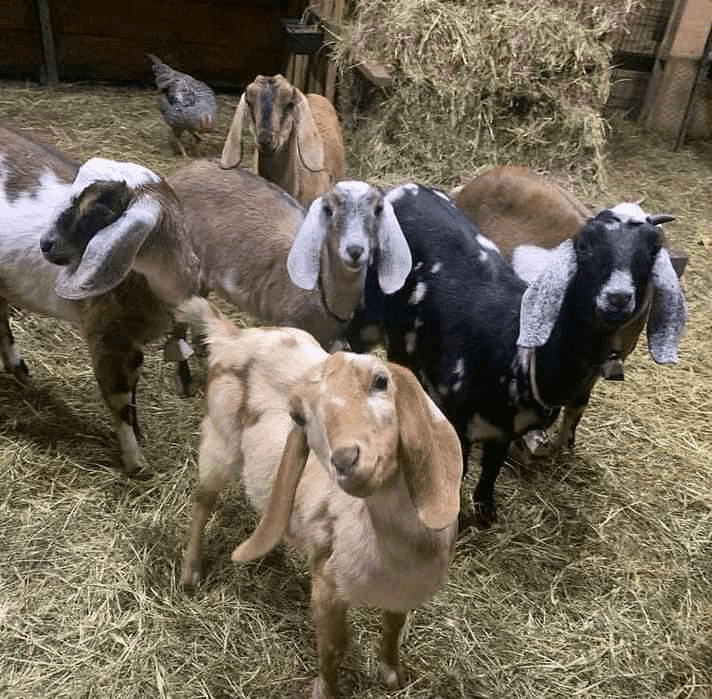
Milking and Milking Procedures
Nubian goats are friendly, curious, and intelligent. These are all things that will make the establishment of a milking routine simple. Before your nanny goat has her kids, get her into the habit of coming to the barn twice a day for a small snack of grain.
Many people milk with the goat standing up on a platform. This helps the milker avoid stooping for long periods of time, which is hard on the back. It also will keep your milk pail out of the dirt and dust on the ground. Of course, since Nubians are taller, larger goats, if you like, you can squat down to milk beside your nanny goat. Get the goat in the habit of being handled while eating a snack. You will want to touch her all over, including her udder and teats. Always be gentle and quiet, so she will associate this time with positive things.
After the doe gives birth, her first milk is colostrum. This rich, thick, yellowish liquid is loaded with vitamins, minerals, and antibodies that will give the kids a good start in life. If you are allowing the kids to nurse on the nanny goat, they will eat their fill of this essential food. Otherwise, remove the kids and milk out the colostrum, feeding it to the kids in a bottle.
After three or four days, the nanny goat’s body will transition from creating colostrum to creating milk. If you have trained your goat well, she will already be in the habit of leaping up onto the platform to be handled. You may want to brush her before milking to remove any loose hairs or dirt that may fall off and get into the milk. Clean her udder with a damp cloth and squeeze a few squirts of milk onto the ground. This first milk may have more bacteria than the rest of the milk. Then, proceed with milking your goat.
Milking Nubian Goats
You can milk Nubian goats by hand into a bucket or with a machine. Both methods have their pros and cons. The bucket method is less expensive and easier to maintain. You don’t have to have electricity in the barn.
An electric milker can be costly, and you also have to clean it daily, which can be involved. For just one goat, a bucket set up is much more practical, but if you have multiple goats to milk, an electric milker may make sense.
After you’ve milked, strain the milk to remove any dirt from it. Then, you can pasteurize it by heating it to 165 degrees for 15 seconds. Cool the milk as quickly as possible. Some people prefer raw (unpasteurized) goat milk. Milk that has been pasteurized should be consumed within 5 to 7 days, while raw milk should be used in the first 3 days. Always label jars with the date that it was milked to keep yourself safe.
Like with all dairy goat breeds, milking Nubian goat does requires cleanliness. Milking buckets should be made of stainless steel. You should scrub and sanitize them daily. Rags used for cleaning the goat’s udder should be washed and sterilized daily.
If you want to practice “share milking” you can avoid having to bottle-feed the kids. Simply pen the kids away from the nanny goats overnight. Milk the goat in the morning, taking that milk for yourself. Then, let the kids run with the does all day. They should have plenty to eat if you are feeding your nanny goat properly.
At peak lactation, a well-fed Nubian doe may produce up to a gallon of milk per day.
Costs
How much a Nubian goat costs depends on many factors, including if it’s registered, age, and breed traits such as coloring, demand, etc. One week old Nubian kids can sell for $250. Registered does, depending on their breeding age, and registered bucks can cost $500+.
Many small-acreage owners choose goats over larger livestock like cattle because they are less expensive, small, and easy to maintain.
Caring for Nubian Goats
In addition to providing food, water, and protection from predators, Nubian goats will need:
Space to browse
Because Nubian goats are a larger breed, they need a bit more space to roam. At least a half acre of pasture in the warm months should be provided for each goat. In winter months when they are penned up in a small fenced area, about 250 square feet should be given for each goat.
If you have a smaller property or may have plans to expand your goat herd, you may want to consider raising mini Nubians.
Goats will attract predators. Having horns will help protect them which may or not be as essential, depending on your property size, predators, fencing, if you have guardian animals (guard dogs, llamas, donkeys) protecting them, etc.
Raise more than one goat
Remember that goats are herd animals and will be incredibly stressed and unhappy if they do not have other goats for company. Some people say that you can use a sheep or other animal for your goat to have a pal. However, it is definitely best for your goat to have another companion goat. Remember that happy goats are less likely to test fences and do other naughty things that will test your patience.
Fencing
Nubian goats need tight, sturdy fencing that is at least five feet tall. An electric wire on the inside of the fence will help keep them in the fence. However, goats like to climb, lean, and rub against fencing so keep this in mind. If it’s used to surround your large acreage, this may not matter as much.
For fencing in smaller areas, it’s best to use 8-foot wooden or metal posts. Ideally, they should be spaced 8 – 10 feet apart and buried at least two feet deep. All the fencing boards should be nailed away from the goats, on the outside of the fencing. This will ensure your goats won’t get at the nails and staples.
If you use woven wire, choose a 4-inch opening to be sure goats don’t stick their heads or horns through it. Cons to woven wire are that it can be difficult to install and somewhat expensive.
It’s essential to choose wire that prevents their horns and heads from becoming trapped. You can also consider cattle or goat panels with graduated spacing for fencing.
Goats are more likely to go under a fence than over, so it’s important to put the bottom wire close to the ground (about 6 inches) to discourage this.
Protective shelter
If you live somewhere where the winters are very cold, your Nubians will need places to get out of the weather. In cold months, you will need a fully enclosed, insulated space. Nubians’ ear tips can get wet when they drink, so you will need to keep them in a place where their ears can dry out without freezing.
In places where winters are mild, a three-sided shed will be adequate, if the open side faces out of the wind.
Hay racks
Nubians, like most goats, will not eat hay that has been soiled, stepped on, or laid upon. Therefore, hay racks that keep the hay elevated off the barn floor make sense. This will prevent excess wasting of the hay. You can also suspend it in a hanging hay netting for them to access.
Good sanitation
Sanitize milking equipment, and clean feeders, water buckets, and pens regularly.
Proactive health care
Clean water, balanced nutrition with opportunities for foraging, sunlight, fresh air, and exercise will go a long way to keeping your goats healthy.
Nubians are not any more prone to parasitic infection than other breeds. However, this is something that you should keep an eye on. Check them using the FAMACHA scale that your veterinarian can explain to you. If you need to deworm the goats, only treat the ones who truly need the medicine. Excessive use of anti-parasitic will lead to medication resistance in the parasites on your farm.
Rotating areas the goats browse will also reduce the risk of parasites. You also should work out a good vaccination schedule with your local veterinarian to keep your herd healthy. Most of the time, does will need to be vaccinated several weeks before they are due to give birth. This will help them pass on excellent antibodies to their kids in their colostrum.
As far as a Nubian goat’s lifespan, on average, with proper care, they typically live to be 15 – 18 years old. Learn how long do goats live to compare Nubians to other goat breeds.
Signs of Healthy Nubian Goats
It is important to check on your goat herd daily to notice any changes. They should be social, alert, eat well and chew their cud. They should have shiny coats, clear and bright eyes, no discharge from their eyes, nose or mouth. Their fecal pellets / droppings should be firm.
Pros and Cons of Raising Nubian Goats
Nubians are wonderful animals, but they may not be for everyone. However, what makes them a positive for some potential goat owners may make them a negative for others. I’m starting with the disadvantages to raising them.
Some cons to raising Nubian goats
First, with Nubians being larger goats, they may be a bit harder for some people to handle. These goats do need their feet trimmed from time to time. They also need things like vetting. If you are not big enough and strong enough to handle these tasks, you may want to buy a smaller breed of goat.
Also, Nubians are notoriously vocal. Especially in the breeding season and when it is time to wean, these goats will tell you about their problems. If you live someplace where the neighbors may complain, you may want to choose a different breed.
Another potential challenge with raising Nubians is while their pendulous ears are completely adorable, they can be a liability in cold weather. The goats will frequently get their ears wet while drinking. If you live somewhere where the winters are cold and harsh, the ends of your goats ears can freeze or become frostbitten. These goats are a better choice for warmer environments with milder winters.
Pros to raising Nubian goats
However, if you want a goat that gives rich, flavorful milk that is perfect for cheese making, the Nubian is a wonderful choice. They are intelligent, friendly, and make good companions. Whether you use the milk for home consumption, to sell and/or to make cheese, they are productive and can provide a good return on investment. They also can provide a sustainable source of meat for your family.
Learn about raising goats for profit and if raising a Nubian goat herd is for you.
Consider your goals for raising goats. Do you want goats for milk, meat, or maybe both? Nubians may be ideal. Also learn about types of goats for land management, fibers, and more.
Goats get along with other livestock as well, adding diversity to your homestead or hobby farm. Learn about the difference between sheep and goats.

